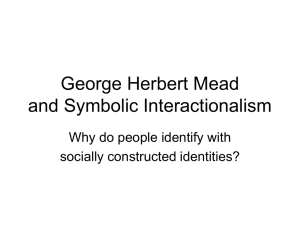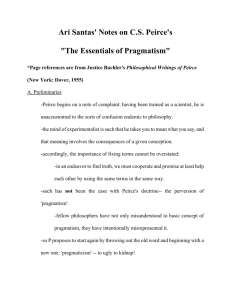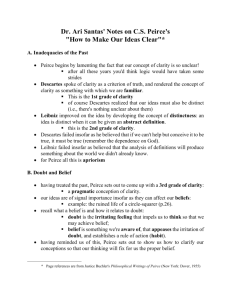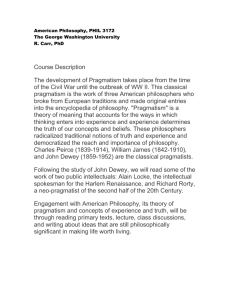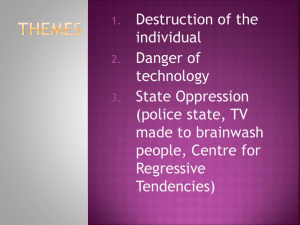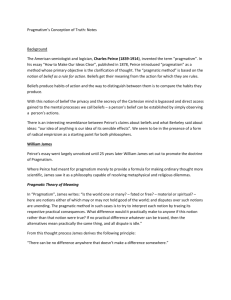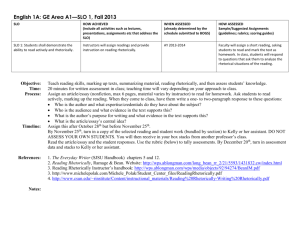Sample Title of a Sample Paper - International Journal for Dialogical
advertisement
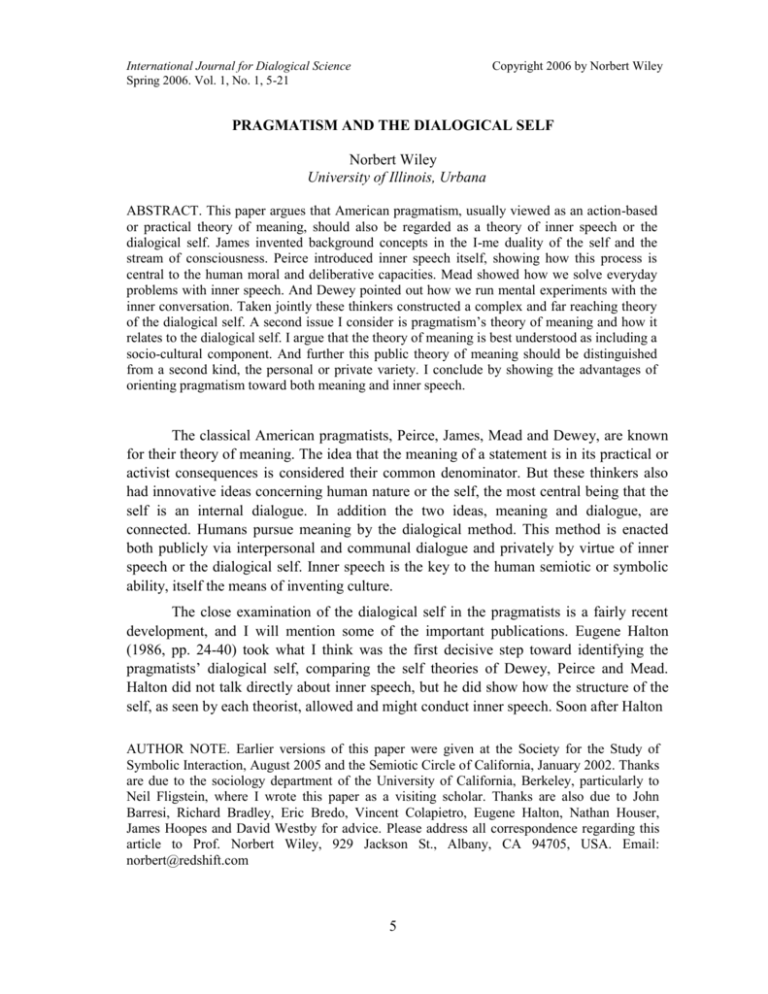
International Journal for Dialogical Science Spring 2006. Vol. 1, No. 1, 5-21 Copyright 2006 by Norbert Wiley PRAGMATISM AND THE DIALOGICAL SELF Norbert Wiley University of Illinois, Urbana ABSTRACT. This paper argues that American pragmatism, usually viewed as an action-based or practical theory of meaning, should also be regarded as a theory of inner speech or the dialogical self. James invented background concepts in the I-me duality of the self and the stream of consciousness. Peirce introduced inner speech itself, showing how this process is central to the human moral and deliberative capacities. Mead showed how we solve everyday problems with inner speech. And Dewey pointed out how we run mental experiments with the inner conversation. Taken jointly these thinkers constructed a complex and far reaching theory of the dialogical self. A second issue I consider is pragmatism’s theory of meaning and how it relates to the dialogical self. I argue that the theory of meaning is best understood as including a socio-cultural component. And further this public theory of meaning should be distinguished from a second kind, the personal or private variety. I conclude by showing the advantages of orienting pragmatism toward both meaning and inner speech. The classical American pragmatists, Peirce, James, Mead and Dewey, are known for their theory of meaning. The idea that the meaning of a statement is in its practical or activist consequences is considered their common denominator. But these thinkers also had innovative ideas concerning human nature or the self, the most central being that the self is an internal dialogue. In addition the two ideas, meaning and dialogue, are connected. Humans pursue meaning by the dialogical method. This method is enacted both publicly via interpersonal and communal dialogue and privately by virtue of inner speech or the dialogical self. Inner speech is the key to the human semiotic or symbolic ability, itself the means of inventing culture. The close examination of the dialogical self in the pragmatists is a fairly recent development, and I will mention some of the important publications. Eugene Halton (1986, pp. 24-40) took what I think was the first decisive step toward identifying the pragmatists’ dialogical self, comparing the self theories of Dewey, Peirce and Mead. Halton did not talk directly about inner speech, but he did show how the structure of the self, as seen by each theorist, allowed and might conduct inner speech. Soon after Halton AUTHOR NOTE. Earlier versions of this paper were given at the Society for the Study of Symbolic Interaction, August 2005 and the Semiotic Circle of California, January 2002. Thanks are due to the sociology department of the University of California, Berkeley, particularly to Neil Fligstein, where I wrote this paper as a visiting scholar. Thanks are also due to John Barresi, Richard Bradley, Eric Bredo, Vincent Colapietro, Eugene Halton, Nathan Houser, James Hoopes and David Westby for advice. Please address all correspondence regarding this article to Prof. Norbert Wiley, 929 Jackson St., Albany, CA 94705, USA. Email: norbert@redshift.com 5 WILEY had unlocked this door Hoopes (1989, pp. 190-233) opened it by systematically comparing the self theories of Peirce, James and Dewey. And independently Colapietro (1989) analyzed Peirce’s theory of self at length, making the first sustained examination of the pragmatists’ dialogical self. Then Perinbanayagam wrote a book chapter on the dialogical self (1991), discussing Buber and Bakhtin as well as Mead and Peirce. Later Wiley (l994) compared Peirce and Mead, showing how each takes the theory of the internal conversation in a somewhat different but complementary direction. More recently Archer (2003) made an innovative analysis and empirical study of pragmatism’s theory of inner speech, covering James, Peirce and Mead. Finally Collins (2004) showed the relevance of the inner speech discussion to a wide variety of theoretical issues. Since this idea is now of considerable interest, it is important to understand how the notion of inner speech began and developed among the pragmatists. This paper will be an overview of how the pragmatists treated this idea, touching on William James, Charles Sanders Peirce, George Herbert Mead and John Dewey. I will also discuss the views of two sociologists who followed the pragmatist tradition, Charles Horton Cooley and Herbert Blumer. Then I will look at the pragmatist’s theory of meaning, showing how it might include a socio-cultural dimension and distinguishing it from the more private systems of meaning all humans seem to have. I will conclude by listing the advantages of including the dialogical self as a central pragmatist issue. William James and Preliminary Concepts There tend to be two approaches to self theory: that the self is a particular kind of feeling or emotion and that the self is a special cognition (Mead, 1934, p. 173). The first is the "self feeling" approach, and its prominent exponents were William James and Charles Horton Cooley. The second is the reflexive approach, or the idea that the self is that which is aware of itself. Peirce, Dewey and Mead followed the reflexive path. James had several ideas that were useful and foundational for the theory of inner speech, but he did not work with the idea as such. The idea of inner speech is a smooth outgrowth of reflexive theory, but it is only indirectly related to self feeling theory. Actually Peirce wrote about inner speech well before James wrote what I am calling background concepts. But, although James’s ideas are not chronologically prior to those of Peirce, they are what might be called “analytically” prior. James's main two relevant ideas, then, were the naming of the “I and me” components of the self and the description of the stream of consciousness. He also got close to the dialogical self, especially in the “divided self” section of the Varieties of Religious Experience (James, 1961, pp. 143-159). But he never specifically named and analyzed this idea. As James puts it in originating the I-me distinction: We may sum up by saying that personality implies the incessant presence of two elements, an objective person, known by a passing subjective Thought 6 PRAGMATISM AND THE DIALOGICAL SELF and recognized as continuing in time. Hereafter let us use the words ME and I for the empirical person and the judging Thought... if the passing thought be the directly verifiable existent which no school has hitherto doubted it to be, then that thought itself is the thinker, and psychology need not look beyond (James 1950, p. 371, 401). For James, then, the "me" is the empirical person, and the "I" is the passing thought, which he equates with the thinker. These definitions are not exactly the same as Mead's I and me, which are the elements of his internal conversation, but they are extremely close. James "thinker” can easily be visualized as communicating with that thinker's empirical self. In fact it seems highly likely that Mead's I-me dialogical self was formed by moving James I-me a short step further.1 James’s identification and analysis of the stream of consciousness is a major contribution to the psychology of the self. This stream is the inner life, including all the feelings, sensations and ideas that flow through the person. James does not emphasize language in this context, but the organizing principle of this stream clearly seems to be language or inner speech. When Mead describes the I-me conversation he is talking about James's stream of consciousness, but with the emphasis on the directing or controlling linguistic feature of that stream. Although James did not say this, I think that any element in this stream, i.e. sensations, emotions, kinesthetic feelings, etc. can function in a linguistically syntactical manner. For example we can say to ourselves "I'd like a drink of water," or we can just picture a drink and say "I'd like that." Non-linguistic elements can also function in interpersonal communication, as in bits of sign language, but they can function far more extensively and smoothly in inner speech, a point I will return to in a later section. Thus sometimes inner speech can just be a small aspect of the stream, but at other times it can embrace wide swatches of this stream. When James's stream of consciousness was used by James Joyce, Virginia Woolf and the other modernist novelists to get at the inner life of their characters, they drew on the linguistic aspect of this stream. (Humphrey 1962). Like Mead, they pushed James a step further, centering on internal speech as the key ingredient of the stream. James then constructed a powerful infra structure for the dialogical self, even though he did not quite explicate the dialogical self as such (but see Hermans and Kempen. 1993, p. 44-45 for the application of James’s I-me distinction to contemporary dialogical self theory). 1 Rochberg-Halton, 1986, pp. 36-38 makes this same point about James and Mead. 7 WILEY Peirce and the Re-discovery of the Dialogical Self Plato made the point that thought was the self talking to itself (Theaetetus, 189e190a and Sophist, 263e). His is the first recognition of the dialogical self in Western thought. Plato did not develop this point, although Socrates' use of the dialogical method certainly resonates with the internal dialogue. Inner speech is not treated again seriously until Augustine picked it up (Matthews, 2002, pp. xvii-xviii). But he did not refer to inner talk in ordinary language, but to talk in the language of thought. In other words Augustine believed that the thought process was quasi-linguistic but was so in a special conceptual language. The syntax was somewhat similar to that of ordinary language, e.g. Latin, but the semantics was not. Instead it consisted purely of abstractions without signs, or in Saussure's terms of signifieds without signifiers. This theory of the language of thought was continually discussed and refined until the 14th century and the time of Occam. (Spade, 1999) And it was Descartes' cogito that ended the language of thought discussion and re-opened the door to the ordinary language of thought.2 But Descartes too did not develop this point except to use it for his cogito. Despite occasional mention of inner speech after Descartes (e.g. Kant, 1978, p. 85) it was not until Peirce that inner speech was clearly identified, thematized and analyzed. Peirce knew the medieval language of thought discussion, but he also knew the relatively thin tradition of viewing inner speech as ordinary language. Peirce showed how inner speech fit into the theory of semiotics and also into the development of the person. Although pragmatists have always been aware of Peirce’s dialogism and its relation to his semiotics, Vincent Colapietro, (1989) was the first to fully grasp the importance of inner speech for Peirce. Peirce has no treatise or extended discussion of inner speech, but he made important brief comments here and there, including in his unpublished papers. Colapietro pieced these fragments together and showed how Peirce used them to explain the moral capacity of humans. In particular Colapietro singled out the way Peirce viewed inner speech as the capability for self determination and self control. A characteristic statement by Peirce is the following: a person is not absolutely an individual. His thoughts are what he is "saying to himself," that is, saying to that other self that is just coming into life in the flow of time. When one reasons, it is the critical self that one is trying to persuade, and all thought whatsoever is a sign, and is mostly of the nature of language. The second thing to remember is that the man's circle of society (however widely or narrowly this phrase may be understood), is sort of a 2 In recent times Jerry Fodor and Noam Chomsky have worked with a language of thought hypothesis commonly referred to as “mentalese,” which is an artificial intelligence version of medieval mental language. 8 PRAGMATISM AND THE DIALOGICAL SELF loosely compacted person, in some respects of higher rank that the person of an individual organism. (1934, p. 421). This text is full of ideas, and I will have to ignore most of them to stay on theme. The most obvious moral point is that we check with our "critical self" in deciding what to do. This gives the individual a certain moral directionality or teleology. But there are two other points in Peirce’s writings that show more clearly how inner speech is involved in moral choice. One has to do with modeling our options, internally, so we can visualize the choices that lie before us. The critical self, which is more or less the conscience, may not give us detailed instructions on how to act. But if we attempt to foresee the various paths along which we might go, we can more clearly see what is right for us. Then we are faced with two distinct acts of choice. One is to choose the internal model, the inner speech scenario that looks best to us. This is already a pre-choice or a preparation for action. Then we choose which action to follow in the world of external behavior. This is choice in the usual sense of the word. But the prechoice of the inner speech selection is a causal factor in how we eventually choose to act. Peirce also discussed inner speech in relation to habit formation and choice, which is merely an extension of the point I have already made. Here Peirce proposes that one can break bad habits and institute good ones by internal modeling of the good. Now a single moral choice is turned into a series of such choices, i.e. a habit. Peirce believed that the internal conversation was a potent weapon for steering one's habits. My impression is that he got these ideas from reading Frederick Schiller's On the Aesthetic Education of Man (1795) as a teenager (Wiley, 2006). This intense book concerns the moral problem of striking a balance between one's physical and spiritual sides by using the aesthetic as a bridge. It was at this point in his life that Peirce conceived the internal conversation as going on among an "I," "Thou" and "It," i.e. the first, second and third persons, grammatically speaking. Peirce may have also modeled these three pronouns against Schiller's triad, for example, the "I" as the mind or spirit, the "it" as the body and the "thou" as the aesthetic bridge between the two. But this is a guess, and Peirce may have merely used the pronouns as pronouns. In any case Peirce seems to have stumbled onto inner speech in a moral context, specifically in the context of his own adolescent formation and quest for identity. Presumably it did him some good in navigating through the teen-age years, and it may have also served him in later years. But Peirce does not seem to have done very well controlling his bad habits, especially gambling, extravagant living, womanizing and taking consciousness-altering drugs (though the latter may have been a self medication for a neurological condition.) My point then is that Peirce re-introduced inner speech into the history of thought (Archer, 2003, p. 65). For him most thought was in inner speech, and by and large 9 WILEY cognition was conducted within the medium of the internal conversation. But within this larger function, he emphasized the power of agency and the moral leverage that inner speech could bring. The fact that Peirce himself did not seem very successful in using this agency is of interest, his bad habits controlling his life. But the tyranny of his habits does not lessen the importance of his re-discovery of inner speech.3 Mead's Internal Conversation of I and Me Here is Mead’s version of the internal conversation. Thinking is a process of conversation with one’s self when the individual takes the attitude of the other, especially when he takes the common attitude of the whole group, when the symbol that he uses is a common symbol, has a meaning common to the entire group, to everyone who is in it and to anyone who might be in it. …There is a field, a sort of inner forum, in which we are the only spectators and the only actors. In that field each one of us confers with himself. He asks and answers questions. He develops his ideas and arranges and organizes those ideas as he might do in conversation with somebody else. (Mead, 1936, pp. 380-381, 401.) As these quotes suggest, Mead contrasts with James in actually developing the Ime distinction into the basis of internal conversation and the dialogical self. But he contrasts with Peirce in the way he structured the internal conversation. For one thing Peirce has the person or "I" talking to his "you," the "self that is just coming into life in the flow of time." But Mead has the self conversing with his "me," which is the self considered as an object. Temporally speaking the me is in the past. Mead often said the me is the I of the previous moment, having passed into the past and having become an addition to the “me." Peirce, then, has the conversation pointed toward the person of the immediate future, and Mead has it pointed toward the person of the immediate past. This pronominal difference between the "me" and the "you" is related to a functional difference in the way the two theorists treat the internal conversation. Both Peirce and Mead regard all thought as primarily conversational. But within this larger category, Peirce emphasized the moral aspect, and Mead, while not neglecting the moral 3 I do not know Peirce’s biography very well and it may be that I am being too hard on him. Here is Eugene Halton’s comment on my remarks: “Though Peirce only came to greater exercise of self-control late, the major ruins of his life came not so much from his vices but from his passion and genius, which tend not to be tolerated in society--not only America then. Little people helped ruin his career--like Salieri did to Mozart in Amadeus: the one who betrayed his divorce to the head of Johns Hopkins, or Palmer at Harvard who blacklisted Peirce in his letter to University of Chicago, or the whole philosophy dept at Harvard in the course of the 20th century, who treated him as a degenerate, even while making use of his ideas and papers stacked in the hallway” (personal communication, October 11, 2005). 10 PRAGMATISM AND THE DIALOGICAL SELF side, emphasized the purely cognitive side. For Mead the internal conversation solves problems, typical ones being whether to use a shoe to pound a nail when a hammer is unavailable, or how to jump across a ditch. Mead also discussed how we talk with the generalized other to calibrate our actions with social morality. But this is not the only cognitive function the generalized other has in his system (Dodds, Lawrence & Valsiner, 1997). When talking of all his main ideas, "sensitizing" concepts that they were, Mead might use somewhat different language from time to time. Among his major concepts were the significant symbol, roletaking, the act, the me, the I and the generalized other. This variation in language reflects Mead's metonymical tendency to use the part for the whole. A concept might have a half dozen key properties or features, and Mead might sometimes refer to it with one aspect and sometimes with another. This variability seems “sloppy,” but it merely reflects the fact that Mead was crafting his concepts as he went along. And you have to watch closely to follow his mind. In the case of the generalized other he seems to deal with several distinct facets of this idea. The best know is the moral one, and in this sense the term means roughly the same as the conscience or Freud's super ego. It is also pretty much the same as Peirce's "critical self." But Mead also interprets the generalized other as a control over our common sense, logic and scientific method. If you use the community’s language you have to follow the semantic and grammatical rules, as suggested by Mead above. More broadly, the community has rules concerning what is rational and cognitively acceptable. If one violates these rules the result is cognitive error or perhaps the more fundamental problems of delusion and hallucination. A third major way in which Mead uses the generalized other was to mean someone we might be talking to – a sort of imaginary companion, listener or "everyman." Lonnie Athens refers to this version of the generalized other with his interesting concept of the "phantom other." (Athens, 1994, p. 525). If we interpreted Mead's generalized other as always and only the conscience, it might appear that his internal conversation was overwhelmingly moral, even more so than Peirce's. And that his person was highly over-socialized (the position taken by Archer, 2003, pp. 78-90). But in fact his generalized other has at least three major aspects: a conscience, a logic machine and an “anyone” with whom we might be conversing. So it is simultaneously moral, cognitive and a sort of placeholder. I think the generalized other also has additional complications, but these three seem major and they help understand the subtlety of Mead's theory of inner speech. An additional confusion comes from the fact that Mead tends to place the generalized other in or near the "me." Given that the me also has several aspects of its 11 WILEY own, the combination of the me and the generalized other must be treated carefully. But this is the way it is with geniuses, especially those who are constructing systems of basic ideas that did not previously exist. They are confusing. But if we do the job of deconstructing their lines of thought, the work is well worth it. Dewey and the Mental Experiment Like the other pragmatists, Dewey thought inner speech was a way of solving problems without overtly carrying out a trial and error process. This ability developed in evolution and it was the distinctive human process, i.e. the key to human intelligence. As Dewey explained it: ... deliberation is a dramatic rehearsal (in imagination) of various competing possible lines of action. It starts from the blocking of efficient overt action...Then each habit, each impulse, involved in the temporary suspension of overt action takes its turn in being tried out. Deliberation is an experiment in finding out what the various lines of possible action are really like. But the trial is in imagination, not in overt fact (1930, p. 190). Dewey’s inner speech is a search process, seeking the best way of reaching some goal. It fits with the thought of James, Peirce and Mead, but it adds an emphasis on genesis, on how blocked action triggered inner speech. This happened both phylogenetically in the primates and ontogenetically in the human infant. Dewey was impressed at what an advance inner speech is in the process of evolution and how it lifts the moral importance of human beings. The modern discovery of inner experience, of a realm of purely personal events that are always at the individual’s command, and that are his exclusively as well as inexpensively for refuge, consolation and thrill is also a great and liberating discovery. It implies a new worth and sense of dignity in human individuality... (1958, p. 172) Here Dewey adds “refuge, consolation and thrill,” suggesting that inner speech has a wide variety of uses other than just basic cognitive search. Cooley and the Imaginary Companion Charles Horton Cooley got most of his insights concerning child development from observing his own two children. He adopted the common view that thought is a process of talking to oneself. And he noted that his children initially thought out loud and later submerged this conversation into silent inner speech. But he had the unique view that early thought occurs when talking to one's imaginary companion. And, evidently because his own children both had imaginary companions, he assumed that all people do. As he says 12 PRAGMATISM AND THE DIALOGICAL SELF When left to themselves children continue the joys of sociability by means of an imaginary playmate. Although all must have noticed this who have observed children at all, only close and constant observation will enable one to realize the extent to which it is carried on. It is not an occasional practice, but, rather, a necessary form of thought.... Thus the imaginary companionship which a child of three or four years so naively creates and expresses is something elementary and almost omnipresent in the thought of a normal person. (1922, pp. 88, 96, emphasis added) Cooley evidently thought the imaginary companion, whom he regarded as present in the lives of all children, was the precursor of the "generalized other" whom adults tend to address when they talk to themselves. However, Taylor (1999) finds that only about 65 percent of children have imaginary companions, and others have reported similar findings. I think this conclusion of Cooley’s is called being right for the wrong reason. He was talking about Mead's generalized other as placeholder, or Athens's phantom other, but I think he had the genesis wrong, at least for the other 35 percent of the population. For people who lacked an imaginary companion, the "anybody" of the internal conversation must be an ordinary abstraction or generalization, formed much like any other abstraction. For people who began with an imaginary companion this generalized other may have a much more intimate and emotionally tinged quality than it has for other people, but there seems to be no research on this question. And despite what seems to be a partial error on Cooley's part, he does cast light on the “generalized other” issue. And there is an interesting convergence among Mead, Cooley and Athens on this question. Blumer and Agency Herbert Blumer also discussed inner speech, referring to it as “self interaction.” He sees all action as directed and guided by inner speech. As he says: By virtue of self-interaction the human being becomes an acting organism coping with situations in place of being an organism merely responding to the play of factors. And his action becomes something he constructs and directs to meet the situations in place of an unrolling of reactions evoked from him. (1969, p. 73). In relation to the determinism of human action he says Yet, one must consider the contention that the process of self interaction has an intrinsic character or logic that prevents the resulting action from fitting into a determinist framework. (quoted in Athens, 1993, p. 171) 13 WILEY Table 1 Pragmatists’ Positions on the Dialogical Self THEORIST TERMS EMPHASIS Peirce Dialogue Self-determination James Stream of Consciousness Monitoring Experience Mead Internal Conversation Problem Solving Dewey Deliberation Mental Experiments Cooley Imaginary Conversations Imaginary Companion Blumer Self interaction Agency Blumer, then, brings up two issues that broaden the inner speech discussion. One is that all human action, not just the more deliberate variety, is guided by inner speech. The other is that, while he does not take a definite position, inner speech might be interpreted as weakening the deterministic framework of ordinary physical science. In other words it might be a major means of human agency. This review of pragmatism and the dialogical self has shown a distinct coherence and thematic unity. The pragmatists have an extremely complex and usable theory of the dialogical self, even though it takes some selection and interpretation to piece it together.4 In the review it was shown that James prepared the conceptual foundations for inner speech, and Peirce, Mead and Dewey each had distinct insights concerning this theory. The terminology differs from theorist to theorist, and this hides the thematic unity to come extent. Peirce tended to talk about “thought” or “dialogue,” Mead referred to the “internal conversation,” and Dewey used the terms “deliberation” and “dramatic rehearsal.” Cooley spoke of “imaginary conversations” and Blumer used the term “self interaction.” Yet they were all talking about inner speech. Another noticeable feature of the pragmatists is that they used very few examples, either from their own self observation or from that of others. They also ignored soliloquies and stream of consciousness dialogues from literature. This held them back, and made it more difficult to theorize inner speech. Yet this is by no means an irredeemable deficiency. Instead it invites further research (for example that of Archer, 2003). 4 James Mark Baldwin, an early psychologist who shared the pragmatists’ ideas introduced the question of how the various psychopathologies affect inner speech (1894, 409-416.) It is now known that each pathology damages inner speech, and presumably also thinking, in a characteristic manner. 14 PRAGMATISM AND THE DIALOGICAL SELF Regarding the uses or functions of inner speech we again saw diversity among these thinkers. All of them emphasized cognition in the broad sense, but they also hit on special uses. Peirce was especially interested in inner speech as it allowed self determination, both for individual actions and for the formation of habits. Mead was interested in how inner speech allowed the discovery of solutions, especially for everyday problems. And Dewey emphasized the systematic way we might run through a series of hypotheses or paths of behavior. Cooley pointed to the way the otherness of the dialogical partner bore a resemblance to the child’s imaginary companion. And Blumer, in the spirit of Peirce, focused on the question of agency and how inner speech helps us form choices. This discussion of terminology and emphases is summarized in Table 1. But despite the variation in how the pragmatists treated inner speech, there is a substantial unity in their discussions. This issue runs like a bright thread through the pragmatists’ writings, and I think it is an important candidate for identifying the main theses of their philosophy. Pragmatism’s Theory of Meaning Now that I have shown how pragmatism might include the dialogical self as one of its central interests, I will show how this interest relates to the theory of meaning. I want to say right away that I will be suggesting two distinct theories of meaning. One is the public sense of meaning, as, for example, it is used in language. This meaning is intersubjective and social, and it is sometimes thought to be the only theory of meaning. But there is also a private or personal sense of meaning, which is the meaning peculiar to one individual. Everyone has personal, possibly quite idiosyncratic, meanings, peculiar to them. These meanings are especially present in their internal conversation or inner speech (Vygotsky, 1987, pp. 266-285). Public Meanings I will first consider public meaning, for personal meaning can be more easily defined once public meaning has been delineated. The pragmatists defined meaning as consequential in a behavioral or action-related sense, but this is only loosely defined in their writings. Peirce, James, Mead and Dewey all defined meaning , but these definitions do not fit well together. One can simply take these as they are and claim the unity of a family relationship, or one can try to make the formulation more precise. Mead and Dewey are pretty close to each other on this issue, and I do not think they are the problem. Instead the difficulty is in reconciling the near-positivist statements of Peirce with the near-idealist statements of James. These two are the outliers in the discussion, and if they can be fit together, Mead and Dewey will fall into place in the middle. I will look at this issue as a social theorist might. There are three major meanings of "consequences" in pragmatism: physical, social and individual. In his Metaphysical Club statement (1878), Peirce emphasized the physical properties of an object, e.g. that a 15 WILEY "hard" object such as a diamond is difficult to scratch. As he put it, “Consider what effects, which might conceivably have practical bearings, we conceive the object of our conception to have. Then, our conception of these effects is the whole conception of the object” (Peirce, 1878, p. 256). In his critique of Descartes, however, his arguments against intuition and for a semiotic view of cognition implied a cultural view of meaning. He allowed social as well as physical consequences. And finally, at the non-physical extreme, James introduced consequences for the individual, which might be present and meaningful only for that individual. Sometimes James connected these consequences to religion as in his “will to believe.” James had willed himself into believing the existence of God, the immortality of the soul and even in free will. These three entities had meaning for him because they had consequences for him as an individual. They felt true and had soothing effects, and this satisfied James’s widened notion of meaning. These effects differ from social consequences in several ways. They are restricted to the individual. They can be constructed in the short term. And they are sometimes deliberately or intentionally created. In contrast the consequences implied by Peirce’s semiotic theory are widely social, constructed over long periods of time and unconsciously or indeliberately formed. Peirce was quite uncomfortable with James’s pragmatic theory of meaning, and he distanced himself from it by calling himself a “pragmaticist.” As I interpret Peirce, physical consequences were eventually regarded as too restrictive. The physical version did not have room for his semiotics, nor did it allow for such non-physical entities as money, language, law and other social institutions. On the other hand individual consequences, as found in James’s version, were too unrestrictive. They were not anchored in society and culture. Socio-cultural consequences then became the core idea of the pragmatic test, i.e. pragmatic meaning was cultural meaning or how people act in relation to an object. The physical consequences were still there, e.g. a mirror reflects objects, but it also allows the social process of grooming. This notion of meaning fit Peirce’s theory of signs. His semiotics implied both intersubjective and intra-subjective dialogue – this dialogue being inherently social. The formulation I am suggesting excludes Peirce’s more positivist definitions of meaning and James’s more idealist or wishful thinking versions. Peirce’s physical consequences are still allowed, but they co-exist with socio-cultural consequences. And James’s cultural consequences are included, but not his idiosyncratic personal ones. In other words up to now I have traded off inclusiveness for clarity. Instead of a widely scattered spread of definitions, the formulation I am suggesting disallows the more extreme definitions but has more unity and clarity. This formulation also clarifies pragmatism’s relation to the social sciences. Peirce’s highly empiricist, 1878 formulation was fit for the physical but not for the social sciences. It excluded those from having meaning. The socio-cultural version, 16 PRAGMATISM AND THE DIALOGICAL SELF however, not only allows room for the social sciences, it can also act as a paradigmatic starting point or meta theory for these sciences (Wiley, 2006). Personal Meanings Now that public meaning has been defined, let me return to its opposite, personal or private meaning. People sometimes make up their own meanings. These may be variations on public meanings, a word or phrase reflecting some experience we attach to it. Or a strong emotion, love or hate, getting linked to it. Or a simple drift in what we allow something to mean. But people can also construct meanings more or less confined to themselves. Ordinary language can be given new meanings, as when people think in a condensed or egocentric manner (Vygotsky, 1987, p. 274; Wertsch, 1985, p. 124). Any sound or signifier can be given a novel meaning in this way, a process limited only by the human imagination. One’s psychopathological symptoms, however mild, can also condition one’s semantics. I think the linguistics of everyone’s inner speech, that is, its semantics and syntax, is substantially different from everyone else’s. This seems to have been believed by James Joyce when he structured the inner voices of his main characters in Ulysses.5 And I would also add my impression that non-linguistic elements in consciousness, such as, sensations, emotions, and kinesthetic routines, can function in one’s internal linguistic system. I formed this hypothesis from self observation, talking with colleagues and, again, from Joyce’s Ulysses. Not only can these elements affect meanings as context. They can also act syntactically as parts of speech. One can say to oneself “I am hungry” in many ways. The “I” can be shaved off, since its presence is understood. And the verb, the “am,” could also be dropped, since it too could be understood. The word “hungry” alone can be a complete thought. Or the emotion of yearning, even of yearning for food, can act as the verb. To feel the discomfort of hunger can be the whole semantics. And hunger can also be designated by sensations, for example, a visual, a taste, a smell or even a sizzle can occupy that niche. Picturing one’s favorite entree or dessert can itself bespeak the hunger. I will not say much about the language of thought, the Medieval version of pure abstractions, the contemporary one of computer messaging or any other version. But if any of these semantic streams existed, they could intermingle with the elaborate structure I have already described. In other words, instead of, or in addition to, words or 5 Joyce carried inner speech about as far as one could in literature. If he had somehow been able to represent inner speech as it actually is, no one could have understood him. He had to find the point where he was close to inner speech but still within the range of intersubjective or communicable language, a point he overshot at times. Presumably Joyce based his writing on self observation of his own inner speech, a skill at which he was superb. 17 WILEY sensations or kinesthetic routines or emotions, one could also have “thought,” in whatever sense one might give to that term. This new stream of meaning, depending on how one used it, would make an already quite private conversation even more private.6 The reason I am looking at private meanings is that they seem to function quite centrally in our flow of consciousness and therefore in the way we regulate our lives. Private meanings, even our own, are not easy to fix upon. Reflecting on them may distort them, so we can catch our own meanings only by a kind of peripheral vision. Still it seems useful to describe the private meaning system here, particularly as a contrast to public meaning. But also as the road into a person’s consciousness. Much as Freud thought dreams were a window on the unconscious, inner speech seems to be a window into consciousness. In fact at times, such as the uncontrolled inner speech before sleep, it may also be a glimpse into the unconscious. To return to the larger theme, public and private meanings can both be defined as consequences. But the consequences of public meanings are physical and social, never purely individual. While those of private meanings are also physical and social, their defining quality is individual consequences. And as I pointed out these personal meanings can draw uniquely and idiosyncratically on several varieties of semantics. This can make them not only non-public but intensely personalized and private. Yet both streams are dialogical. Public meanings are communicated in the public community, with the dialogue varying from cooperation to competition and conflict. Private meanings are communicated in people’s inner speech. The two streams, public and private, interlock in complicated relations of cause, effect, competition, coexistence, domination, etc. I will not try to analyze these relations except to point out that they connect two different semantic regions. Public meanings draw on public consequences, and private meanings are built on private consequences. The first is the home ground of Peirce and the second is that of James. Together in relation, they reflect the tension that united, and sometimes disunited, the classical pragmatists. They also reflect the two interests I see as central to pragmatism, the theory of meaning and that of the dialogical self.7 Conclusion I will conclude by pointing out some advantages of centering pragmatism around the dialogical self. 6 I am using the word “private” in a purely factual sense, without necessarily implying that inner speech can be a private language in Wittgenstein’s technical sense. 7 Contemporary research on the dialogical self or inner speech also reflects the public and private theories of meaning. In particular the discipline of psychology, along with neighboring disciplines, is now engaging in a rich variety of approaches to the dialogical self, e.g. in Culture and Personality, 2001. 18 PRAGMATISM AND THE DIALOGICAL SELF a. The theory of meaning, which has usually been thought of as the central theme of pragmatism, is somewhat confusing. It differs substantially from pragmatist to pragmatist, and even its author, Peirce, changed his formulation from time to time. The dialogical self is a much more coherent theme, integrating the relative contributions of the major pragmatists. In addition, it explains the process of interpreting meaning. In other words the dialogical process explains the theory of meaning, and meaning motivates the dialogical process. b. The pragmatist theory of meaning was often thought to be a variant or precursor of logical positivism’s theory of meaning. Thus when logical positivism declined, pragmatism also suffered a loss. But if the theory of meaning is both reformulated and linked to the dialogical process, this distances pragmatism from logical positivism and gives it a clear and original focus of its own. c. The theory of the self shows how pragmatism was influential for the modern social sciences. In particular the anthropological concept of culture, which was the meta paradigm or umbrella concept for the social sciences, was virtually identical with Peirce’s concept of semiotics (Wiley, 2006) and was also implied by the pragmatists’ theory of the self. And the dialogical self is a central concept for social psychology and sociology, including the theory of social construction. d. The dialogical self is a distinct version of the “decentered self,” a central idea of post modernism. Derrida was influenced by Peirce’s idea of semiotics as an endless process of interpretation, but the dialogical self shows how pragmatism had many of the ideas of post-modernism. e. The dialogical self is now a popular concept, used in areas ranging from psychotherapy to film theory. In other words the dialogical focus places pragmatism at the heart of much contemporary thought. f. Finally, to shift directions, pragmatism’s dialogical or semiotic self shows how people’s minds and not their physical or racial traits create cultures and sub-cultures. This idea of the self explains the fundamental equality of human nature and the foundation for egalitarianism, giving it an affinity with democracy (Wiley, 2006). References Archer, M. S. (2003). Structure, agency and the internal conversation. Cambridge, UK: Cambridge University Press. Athens, L. (1993). Blumer’s advanced course on social psychology. Studies in Symbolic Interaction, 14, 163-193. Athens, L (1994). The self as soliloquy. The Sociological Quarterly, 35, 521-532. Baldwin, J.M. (1968). Mental development in the child and the race. New York: Augustus M. Kelley Publishers. (Original work published 1894) 19 WILEY Colapietro, V. (1989). Peirce’s approach to the self. Albany: SUNY Press. Collins, R. (2004). Internalized symbols and the internal process of thinking. In R. Collins, Interaction ritual chains (pp. 183-220). Princeton: Princeton University Press. Cooley, C. H. (1992). Human nature and the social order. New Brunswick, NJ: Transaction Publishers. (Original work published 1922) Culture and Psychology, 7(3). (2001). [Special issue on Culture and the Dialogical Self: Theory, Method and Practice.] Dewey, J. (1930). Human nature and conduct. New York: Modern Library. (Original work published 1922) Dewey, J. (1958). Experience and nature. New York: Dover Publications, Inc. (Original work published 1929) Dodds, A. E., Lawrence, J. A., & Valsiner, J. (1997). The personal and the social: Mead’s theory of the ‘Generalized other.’ Theory & Psychology, 7, 483-503. Hermans, H. J. M., & Kempen, H. J. G. (1993). The dialogical self: Meaning as movement. San Diego: Academic Press. Hoopes, J. (1989). Consciousness in New England. Baltimore: The Johns Hopkins University Press. Humphrey, R. (1962). Stream of consciousness in the modern novel. Berkeley, CA: University of California Press. James, W. (1950). The principles of psychology. Volume One. New York: Dover Publications. (Original work published 1890) James, W. (1970). The varieties of religious experience. New York: Collier Books. (Original work published 1902) Kant, I. (1978). Anthropology from a pragmatic point of view. Carbondale, IL: Southern Illinois University Press. (Original work published 1800) Matthews, G. B. (2002). Introduction. In G. B. Matthews (Ed.), Augustine, On the Trinity (pp. ix-xxxii). Cambridge, UK: Cambridge University Press. Mead, G. H. (1962). Mind, self, & society. Chicago, IL: University of Chicago Press. (Original work published 1934) Mead, G. H. (1972). Movements of thought in the nineteenth century. Chicago, IL: University of Chicago Press. (Original work published 1936) 20 PRAGMATISM AND THE DIALOGICAL SELF Peirce, C. S. (1986). How to make our ideas clear. In C. S. Peirce, Writings of Charles S. Peirce. Volume 3. (pp. 257-276). Bloomington, IN: Indiana University Press. (Original work published 1878) Peirce, C. S. (1934). Pragmatism and pragmaticism. Vol. V. of Collected Papers of Charles Sanders Peirce. Cambridge, MA: Harvard University Press. Perinbanayagam, R.S. (1991). The dialogical self. In R.S. Perinbanayagam, Discursive Acts (pp. 5-25). New York: Aldine de Gruyter. Rochberg H. E. (1986). Meaning and modernity. Chicago, IL: University of Chicago Press. Schiller, F. (1967). On the aesthetic education of man. Oxford, UK: Oxford at the Clarendon Press. (Original work published 1795) Spade, P. V. (Ed.). (1999). The Cambridge companion to Ockham. Cambridge, UK: Cambridge University Press. Taylor, M. (1999). Imaginary companions and the children who create them. New York: Oxford University Press. Vygotsky, L. S. (1987). The collected works of L. S. Vygotsky. Vol. 1. Problems of general psychology (R. W. Rieber & A. S. Carton, Eds.; N. Minick, Trans.). New York: Plenum Press. Wertsch, J. V. (1985). Vygotsky and the social formation of mind. Cambridge, MA: Harvard University Press. Wiley, N. (2006). Peirce and the founding of American sociology. Journal of Classical Sociology, 6, 23-50. Wiley, N. 1994. The semiotic self. Chicago, IL: University of Chicago. 21 22
